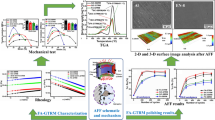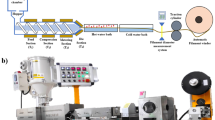Abstract
Waste vegetable oils are highly valued for industrial uses. Thermal processing of these oils alters their physicochemical properties, necessitating an examination of how temperature affects their qualities. The idea of abrasive flow machining (AFM) media to finish any complex shapes and surfaces can also be accomplished using waste vegetable oils and waste coal ash. In this paper, to finish FDM parts, waste coal ash was used to develop an environmentally friendly and sustainable AFM finishing media that contains SiC powder as abrasive particles, waste vegetable oil as a liquid synthesizer, and glycerin as an additive. Taguchi's orthogonal array L9-based experimental design was used to optimize the viscosity of AFM media for better surface improvement. One of the fundamental limitations of fused filament fabrication or fused deposition modeling (FFF/FDM) is the inherent surface quality of the process, which is particularly tied to the layer thickness utilized during manufacture. The FDM technique was used in the current study to fabricate the ABS (acrylonitrile–butadiene–styrene) material's hemispherical ball-shaped workpiece, which was subsequently finished with a one-way AFM process. The present study focuses on the analysis of newly developed AFM media using rheological tests, Fourier Transform Infrared (FTIR) spectroscopic method, thermogravimetric analysis (TGA), and finishing experiments on FDM printed hemispherical ball-shaped workpieces to assess the effectiveness of newly developed media in comparison to traditional media. For FDM printed hemispherical ball-shaped workpieces, the largest percentage improvement in average surface roughness (Ra) achievable by coal-ash-based medium (50% coal-ash) is 83%. The initial surface roughness was improved by 83.67%, from 9.80 to 01.60 µm.



















Similar content being viewed by others
References
Mali, H.S., Manna, A.: Current status and application of abrasive flow finishing processes: a review. undefined, 2009, Accessed Nov. 10, 2021. https://www.semanticscholar.org/paper/Current-status-and-application-of-abrasive-flow-A-Mali-Manna/720d8d016df0889385a561def828c19af3f1e71b
Sambharia, J., Mali, H.S.: Recent developments in abrasive flow finishing process: a review of current research and future prospects. Proc. Inst. Mech. Eng. Part B J. Eng. Manuf. 201, 10 (2017). https://doi.org/10.1177/0954405417731466
Mali, H.S., Prajwal, B., Gupta, D., Kishan, J.: Abrasive flow finishing of FDM printed parts using a sustainable media. Rapid Prototyp. J. 24, 593–606 (2018)
Williams, R.E., Melton, V.L.: Abrasive flow finishing of stereolithography prototypes. Rapid Prototyp. J. 4, 56–67 (1998)
Kumbhar, N.N., Mulay, A.V.: Post processing methods used to improve surface finish of products which are manufactured by additive manufacturing technologies: a review. J. Inst. Eng. India Ser. C 99(4), 481–487 (2018)
Chohan, J.S., Singh, R.: Pre and post processing techniques to improve surface characteristics of FDM parts: a state of art review and future applications. Rapid Prototyp. J. 23(3), 495–513 (2017)
Hashmi, A.W., Mali, H.S., Meena, A.: Improving the surface characteristics of additively manufactured parts: A review. Mater. Today Proc. (2021). https://doi.org/10.1016/j.matpr.2021.04.223
Hashmi, A.W., Mali, H.S., Meena, A.: The surface quality improvement methods for FDM printed parts: a review. In: Fused Deposition Modeling Based 3D Printing, pp. 167–194 (2021). https://doi.org/10.1007/978-3-030-68024-4_9
Hashmi, A.W., Mali, D.H.S., Meena, A.: Surface quality improvement methods of additively manufactured parts: a review. Solid State Technol. 63(6), 6 (2020)
Hashmi, A.W., Mali, H.S., Meena, A.: Experimental investigation of an innovative viscometer for measuring the viscosity of Ferrofluid. Mater. Today Proc. (2021). https://doi.org/10.1016/j.matpr.2021.09.404
Gennaro, L., Bocca, A.P., Modesti, D., Masella, R., Coni, E.: Effect of biophenols on olive oil stability evaluated by thermo-gravimetric analysis. J. Agric. Food Chem. 46, 4465–4469 (1998)
Felsner, M.L., Matos, J.R.: Análise da Estabilidade Térmica e Temperatura de Oxidacao de Oleos Comestíveis Comerciais por Termogravimetria. An. Assoc. Bras. Quim. 47, 308–312 (1998)
Moretto, E., Fett, R.: Tecnologia de Óleos e Gorduras na Indústria de Alimentos. Varela, São Paulo (1998)
Kowalki, B.: Determination of oxidative stability of edible vegetable oils by pressure differential scanning calorimetry. ThermochimicaActa 156, 347–358 (1989)
Lee, S., Min, D.B.: Effects of quenching, mechanisms and kinetics of carotenoids in chlorophyll-sensitized photo oxidation of soybean oil. J. Agric. Food Chem. 38, 1630–1634 (1990)
Santos, J.C.O., Santos, A.V., Souza, A.G., Prasad, S., Santos, I.M.G.: Thermal stability and kinetic study on thermal decomposition of commercial edible oils by thermo-gravimetry. J. Food Sci. 67, 1393–1398 (2002)
Lachenmeier, D.W.: Rapid quality control of spirit drinks and beer using multivariate data analysis of Fourier transform infrared spectra. Food Chem. 101, 825–832 (2007)
Duarte, I.F., Barros, A., Delgadillo, I., Almeida, C., Gil, A.M.: Application of FTIR spectroscopy for the quantification of sugars in mango juice as a function of ripening. J. Agric. Food Chem. 50, 3104–3111 (2002)
Rusak, D.A., Brown, L.M., Martin, S.D.: Classification of vegetable oils by principal component analysis Of FTIR spectra. J. Chem. Educ. 80, 541 (2003)
Rohman, A., Man, Y.B.C., Ismail, A., Hashim, P.: Application of FTIR spectroscopy for the determination of virgin coconut oil in binarymixtures with olive oil and palm oil. J. Am. Oil Chem. Soc. 87(6), 601–606 (2010)
Rohman, A., Man, Y.B.C.: Quantification and classification of corn and sunflower oils as adulterants in olive oil using chemo metrics and FTIR spectra. Sci. World J. 2012, 1–6 (2012)
Carmona, M.A., Lafont, F., Jiménez-Sanchidrisn, C., Ruiz, J.R.: Raman spectroscopy study of edible oils and determination of the oxidative stability at frying temperatures. Eur. J. Lipid Sci. Technol. 116(11), 1451–1456 (2014). https://doi.org/10.1002/ejlt.201400127
Xiao-Fang Zhang; Ming-Qiang Zou; Xiao-Hua Qi; Feng Liu; Cheng Zhang; Feng Yin,: Quantitative detection of adulterated olive oil by Raman spectroscopy and chemometrics. J. Raman Spectrosc. 42(9), 1784–1788 (2011). https://doi.org/10.1002/jrs.2933
Zaitsev, S.Y., Voronina, ОA., Dovzhenko, N.A., Milaeva, I.V., Tsarkova, M.S.: Comprehensive analysis of the colloid biochemical properties of animal milk as complex multicomponent system. BioNanoScience 7, 26–31 (2017)
Munajad, A., Subroto, C.: Suwarno, Fourier transform infrared (FTIR) spectroscopy analysis of transformer paper in mineral oil-paper composite insulation under accelerated thermal aging. Energies 11, 1–12 (2018)
Abdulkadir, I., Uba, S., Salihu, A.A., Almustapha, M.N.: A rapid method of crude oil analysis using FT-IR spectroscopy. Niger. J. Basic Appl. Sci. 24, 47–55 (2016)
Sambharia, J., Mali, H.S.: Characterization and optimization of rheological parameters of polymer abrasive gel for abrasive flow machining. J. Mater. Sci. Surf. Eng. 5, 549–555 (2017)
Wei, H., Peng, C., Gao, H., Wang, X., Wang, X.: On establishment and validation of a new predictive model for material removal in abrasive flow machining. Int. J. Mach. Tool Manuf. 138, 66–79 (2019). https://doi.org/10.1016/j.ijmachtools.2018.12.003
Cheng, K., Shao, Y., Bodenhorst, R., Jadva, M.: Modeling and simulation of material removal rates and profile accuracy control in abrasive flow machining of the integrally bladed rotor blade and experimental perspectives
Nguyen, D.N., Dao, T.P., Prakash, C., Singh, S., Pramanik, A., Krolczyk, G., Pruncu, C.I.: Machining parameter optimization in shear thickening polishing of gear surfaces. J. Market. Res. 9(3), 5112–5126 (2020)
Sandhu, K., Singh, G., Singh, S., Kumar, R., Prakash, C., Ramakrishna, S., Pruncu, C.I.: Surface characteristics of machined polystyrene with 3D printed thermoplastic tool. Materials 13(12), 2729 (2020)
Poomathi, N., Singh, S., Prakash, C., Subramanian, A., Sahay, R., Cinappan, A., Ramakrishna, S.: 3D printing in tissue engineering: a state of the art review of technologies and biomaterials. Rapid Prototyp. J. 26, 1313–1334 (2020)
Hashmi, A.W., Mali, H.S., Meena, A., Puerta, V., Kunkel, M.E.: Surface characteristics improvement methods for metal additively manufactured parts: a review. Adv. Mater. Process. Technol. 2022, 1–40 (2022)
Prakash, C., Singh, G., Singh, S., Linda, W.L., Zheng, H.Y., Ramakrishna, S., Narayan, R.: Mechanical reliability and in vitro bioactivity of 3D-printed porous polylactic acid-hydroxyapatite scaffold. J. Mater. Eng. Perform. 30(7), 4946–4956 (2021)
Nugroho, W. T., Dong, Y., Pramanik, A.: Dimensional accuracy and surface finish of 3D printed polyurethane (PU) dog-bone samples optimally manufactured by fused deposition modelling (FDM). Rapid Prototyp. J. (2022) (ahead-of-print).
Chohan, J.S., Kumar, R., Yadav, A., Chauhan, P., Singh, S., Sharma, S., Rajkumar, S.: Optimization of FDM printing process parameters on surface finish, thickness, and outer dimension with ABS polymer specimens using taguchi orthogonal array and genetic algorithms. Math. Problems Eng. 2022, 1–13 (2022)
Mohanty, A., Nag, K.S., Bagal, D.K., Barua, A., Jeet, S., Mahapatra, S.S., Cherkia, H.: Parametric optimization of parameters affecting dimension precision of FDM printed part using hybrid Taguchi-MARCOS-nature inspired heuristic optimization technique. Mater. Today Proc. 50, 893–903 (2022)
Barzegar, A., Adibi, H., Pakravan, M.J.: The surface and subsurface integrity in coupled operation of fused deposited modeling and centrifugal disk finishing. Rapid Prototyp. J. (2022) (ahead-of-print)
Lavecchia, F., Guerra, M.G., Galantucci, L.M.: Chemical vapor treatment to improve surface finish of 3D printed polylactic acid (PLA) parts realized by fused filament fabrication. Prog. Addit. Manuf. 7(1), 65–75 (2022)
Chohan, J.S., Mittal, N., Singh, R., Singh, U., Salgotra, R., Kumar, R., Singh, S.: Predictive modeling of surface and dimensional features of vapour-smoothened FDM parts using self-adaptive cuckoo search algorithm. Prog. Addit. Manuf. 2022, 1–14 (2022)
Hashmi, A.W., Mali, H.S., Meena, A.: Design and fabrication of a low-cost one-way abrasive flow finishing setup using 3D printed parts. Mater. Today Proc. (2022).
Hashmi, A.W., Mali, H.S., Meena, A.: Experimental investigation on abrasive flow Machining (AFM) of FDM printed hollow truncated cone parts. Mater. Today Proc. 56, 1369–1375 (2022)
Akhtar, S., Khalid, N., Ahmed, I., Shahzad, A., Suleria, H.A.R.: Physicochemical characteristics, functional properties, and nutritional benefits of peanut oil: a review. Crit. Rev. Food Sci. Nutr. 54(12), 1562–1575 (2014)
Subramanian, S., Devadasan Racheal, P.A., Sathianathan, R.V., Rajagopal, A.: Structural and dielectric properties of groundnut oil, mustard oil and ZnO nanofluid. Iran. J. Sci. Technol. Trans. A Sci. 43(3), 1351–1359 (2019)
Bhatt, A., Priyadarshini, S., Mohanakrishnan, A.A., Abri, A., Sattler, M., Techapaphawit, S.: Physical, chemical, and geotechnical properties of coal fly ash: a global review. Case Stud. Constr. Mater. 11, e00263 (2019)
Tiernan, H., Byrne, B., Kazarian, S.G.: ATR-FTIR spectroscopy and spectroscopic imaging for the analysis of biopharmaceuticals. Spectrochim. Acta Part A Mol. Biomol. Spectrosc. 241, 118636 (2020)
Xu, J.L., Thomas, K.V., Luo, Z., Gowen, A.A.: FTIR and Raman imaging for microplastics analysis: state of the art, challenges and prospects. Trends Anal. Chem. 119, 115629 (2019)
Acknowledgements
The authors would like to thank the Science and Engineering Research Board, Department of Science and Technology, Government of India for supporting this work through the grant DST-SERB EMR/2016/003372. Authors are also grateful to the material research center (MRC) at Malaviya National Institute of Technology (MNIT), Jaipur (Rajasthan), India, for providing me with AFM media characterization facilities, such as FTIR and TGA, to assess the success of my Ph.D. research.
Author information
Authors and Affiliations
Corresponding author
Ethics declarations
Conflict of interest
The authors declare that they have no conflict of interest.
Additional information
Publisher's Note
Springer Nature remains neutral with regard to jurisdictional claims in published maps and institutional affiliations.
Rights and permissions
About this article
Cite this article
Hashmi, A.W., Mali, H.S., Meena, A. et al. A newly developed coal-ash-based AFM media characterization for abrasive flow finishing of FDM printed hemispherical ball shape. Int J Interact Des Manuf 17, 2283–2298 (2023). https://doi.org/10.1007/s12008-022-00982-2
Received:
Accepted:
Published:
Issue Date:
DOI: https://doi.org/10.1007/s12008-022-00982-2




